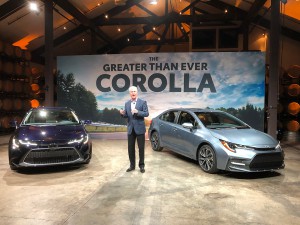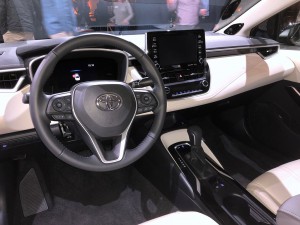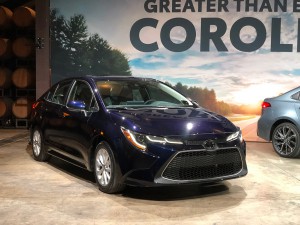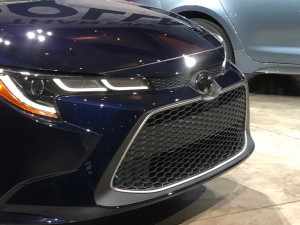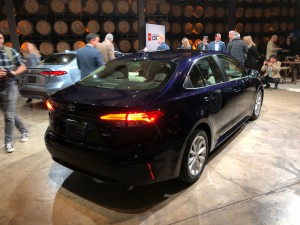It may be an SUV-crazed market, but Toyota is not going to cede ground in the compact sedan market without a fight, or so brand boss Jack Hollis declared during the unveiling of the all-new, 2020 Corolla Thursday night.
It’s no surprise that Toyota is intent on proving its prowess with the new sedan. Over the past half century, Corolla has been one of the cars instrumental in building the Japanese automaker’s reputation for quality, reliability and durability. But with other manufacturers, like Korea’s Hyundai and Kia, breathing down its neck, Toyota will have to show it can deliver more than the classic, plain vanilla design, Corolla has also long been known for.
It hinted at a more expressive direction earlier this year with the launch of a new, and decidedly more sporty , Corolla Hatchback. Now, the mainstay sedan gets a complete makeover. And it is not only more stylish, but boasts more power and lots more features, including the latest version of the Toyota Safety Sense package which now will be standard on all Corolla grades. Key competitors, such as Honda, have chosen not to package these advanced driver assistance systems on many of their base models.
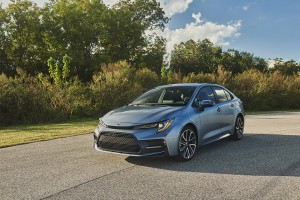
The new Corolla will be offered with two engine options initially, with a 1st-ever hybrid to follow.
(Is Toyota next to start paring back its passenger car line-up? Click Here for more.)
“We’re investing in our sedans,” said Jack Hollis, the head of the Toyota brand in the U.S. market, during a conversation with reporters after the webcast unveiling of the 2020 Corolla. And the automaker is confident that strategy will pay off. While the outgoing sedan/hatchback combo suffered an 11.2% decline in sales for the first 10 months of the year, Hollis insisted that, with the new model, “We may see stable sales, maybe even pick up a little.”
That would be a significant feat in a market where sedans, on the whole, have lost more than 10 points of market share just since mid-decade.
Like the rest of the Toyota sedan line-up, the 2020 Corolla undergoes a significant makeover, both inside and out. The sedan picks up some of the styling cues of the hatchback, notably the J-shaped headlamps. In a departure for the segment, all versions of the new Corolla will feature LED lamps, front and rear. The grille stays in line with the latest versions of the Camry and Avalon, with a wide-mouthed, honeycomb grille meant to give the car a more sporty and aggressive appearance. Overall, there’s a bit more sculpting to the new Corolla.
The interior moves away from the cut-rate plastic feel that has been faulted by critics on the outgoing Corolla. There’s a clear move up-market in terms of materials, with a more refined cabin layout that has the instrument cluster and an 8-inch touchscreen display rising above an otherwise horizontal dashboard layout.
Along with an extensive array of safety features – which include forward collision warning with auto-braking and the ability to stay centered in one’s lane, the new Corolla gets the latest version of Toyota’s infotainment technology, dubbed Entune 3.0. The car can now give a driver access to Amazon’s Alexa voice assistant. Curiously, though, while there’s built-in Apple CarPlay, missing is Android Auto. A driver, meanwhile, will now be able to use an Apple smartwatch to remotely start the Corolla. And, optional, is a 9-speaker, 800-watt JBL sound system.
Under the skin, the 2020 Toyota Corolla rides on the automaker’s new Toyota New Generation Architecture, a platform shared with a wide range of products, including the latest version of the Prius, as well as the Camry.
For the Corolla, it means a 106.3-inch wheelbase. That’s slightly shorter than before, and the front and rear overhangs were trimmed by a combined 2 inches, as well. At a time when many motorists say they like the extra height of a utility vehicle, Corolla moves in the other direction, its height reduced 0.8 inches, while its hood also was dropped, in this case by 1.4 inches, improving forward visibility, Toyota notes. The car is a wee bit wider, the front track gaining 0.47 inches, the rear 0.87 inches.
Toyota also notes that the new layout means the center of gravity drops more than a third of an inch which, goes the promise, will improve handling – never a Corolla strong point. We’ll have to wait for the drive of the new model early in 2019 to see if that promise is delivered on.
Performance is another area where the Corolla has traditionally gotten a middling grade. But Toyota hopes to impress with a choice of two engines – for now. That includes both the carryover 1.8-liter inline-four engine making 139 horsepower and 126 pound-feet of torque, as well as the 2.0-liter direct-injection four introduced on the Corolla Hatch. It punches that up to 169 hp and 151 lb-ft. Making as much as 40 mpg on the highway, the carryover package will have its appeal, but the 2.0-liter engine should gain a new following for Corolla.
(Toyota earnings surge despite weak U.S. sales. Click Here for the breaking news.)
As for transmissions, there’s even a six-speed manual on the sporty Corolla SE – with rev-matching, no less – but most buyers will opt for the carryover CVT gearbox, Toyota is betting.
Meanwhile, for those who want even better mileage, Toyota is expected to provide details about a first-ever Corolla Hybrid when the new sedan gets its official, public debut at the Los Angeles Auto Show late this month.
Since the Corolla was first introduced in 1966, Toyota has sold more than 45 million of the compact sedans and hatchbacks, making it the best-selling model in automotive history. No wonder it is putting so much into the launch of the Corolla at a time when competitors are cutting back, even pulling out entirely from the passenger car market.
Jim Lentz, Toyota’s U.S. CEO, said earlier this month that the carmaker may also trim back some slow-selling models, many observers pointing to the subcompact Yaris or, perhaps, the smallest version of the Prius family, the Prius C. On Thursday, brand boss Hollis appeared to backpedal a bit, insisting nothing is imminent in terms of a cut in the Toyota line-up. But he clearly did not rule it out.
(It’s official. Click Here to find out when and where the reborn Toyota Supra will debut.)
That said, Toyota appears to be serious about building back up Corolla sales. It will continue to produce the nameplate at its Takaoka plant in Japan, as well as a factory in Mississippi. But it’s also looking to add capacity at the new assembly plant it is setting up in Alabama in a partnership with Mazda. That will open in a couple years’ time.
Hollis admitted he doesn’t know when the shift to SUVs will level out. Most analysts expect that trend to continue for at least a few more years. But, if Toyota’s strategy works, it could be well-positioned for a rebound in passenger car sales.
The plan will start being tested when the 2020 Toyota Corolla rolls into U.S. showrooms next March.
(Joe Szczesny contributed to this report.)

